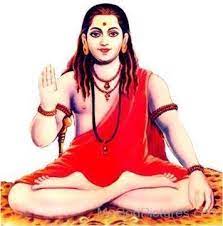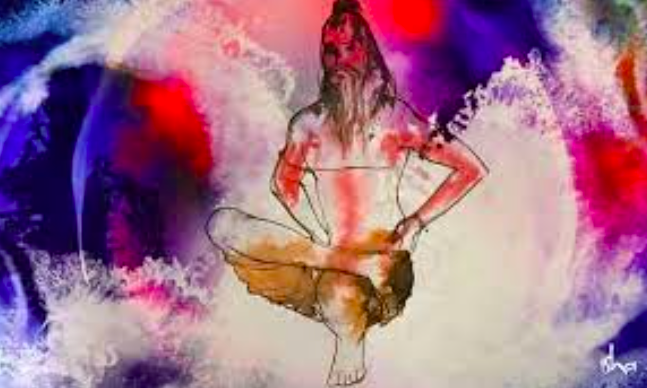Gorakhnath Baba, Navnath:
Since ancient times there has been a Nath Parampara in India. This tradition has been considered an important part of Sanatan Dharma.
The real gems of this parampara have been the naathis who are 9 in number. They are known as Navnaths.

Guru Gorakhnath was one of the prime naths in this tradition. He is considered to be an incarnation of Lord Shiva and is known as a Maha Yogi of ancient India. He is considered one of the most influential founders of the Nath Hindu monastic movement in India. He is very popular in Maharashtra and his devotees are found at Garbhagiri in Ahmednagar, Maharashtra. His followers are known as Gorakhnaathis or Kanphata Yogis because of their pierced ears with a large metal or bone ring.
His unusual birth:
It is widely believed that Guru Gorakhnath was not born out of a mother’s womb, but he was created out of cow dung. Once Guru Matsyendranath went for some bheeksha to a poor lady’s home. When the guru reached there he found her weeping inconsolably. On seeing Matsyendranath she fell at his feet, crying. The Guru was overcome with pity and asked her why she was crying. The woman replied that she was childless even after being married for several years. She implored Baba that he give her a boon to become a mother and fulfill her wish of becoming a mother.
Guru Matsyendranath started chanting some magic mantras and from his pouch took out a bhasm or magic powder and gave it to the woman instructing her to partake of this bhasm and her wish would be fulfilled.
The woman took the bhasm and showed it to her friends who laughed at her. They questioned how a bhasm can make a woman pregnant. They further advised her that the yogi must be a fake one and to throw the powder away. Heeding their words of advice the woman threw the bhasm away in a pile of cow dung.
Twelve years passed by and the woman was unable to conceive a child. As luck would have it, one day Guru Matsyendranath happened to pass by. He went to the woman and addressed her, “Mother how are you? How is your son? He must be big now”.
On hearing him the woman started crying and told him the whole sorry tale of the fate of the bhasm. The great yogi told her that it was a magical bhasm and they are never fake. He requested the lady to take him to the cow dung heap. When they reached there he started calling out to the boy, and lo and behold! A 12-year-old boy emerged from the dung heap. As the boy had emerged out of the cow dung, the Yogi named him Gorakhnath and took the boy with him on his travels.
Matsyendranath and Gorakhnath an example of guru shishya relationship:
But the strong-headed Gargi had more intellectual and spiritual goals in her mind. She was greatly interested in learning the Vedas and Puranas. She was endowed with great intelligence and became proficient in the complex philosophies of all four Vedas.
Even men who strived to be her equal in intellect could not surpass her knowledge in this field. Rishi Gargi as she is known is even mentioned in the Rigveda; in its Griha Sutra. Through her deep meditation, she revealed some of the mantras in the Rigveda. Her views on philosophy are considered so exalted that they find mention in the Chandyog Upanishads.
Gorakhnath later went on to become one of the most famous yogis in India. He is considered a jewel amongst the yogis. His guru was Yogi Matsyendranath who is himself considered as Lord Shiva. Gorakhnath was very fiercely devoted to his guru. The guru saw his disciple getting too fierce in his emotions and love for his guru; almost like a soldier and not like a yogi. So the guru orders Gorakhnath to go away to the Himalayas and do sadhana for 14 years to tame his emotions. But Gorakhnath only agrees because of his love for his guru, and nothing else.
During the 14 years of his sadhana, Gorakhnath counted each moment of every day when he would be united with his guru. Because of this long sadhana, he attained several powers but he did not use them even though he was aware of them.
After the stipulated 14 years were over, Gorakhnath walked down from the Himalayas and across the land to the foothills of the Sahyadri mountains in the Deccan plateau. He had only one thought in mind; to meet his guru.
As he approached the cave where Matsyendranath was meditating he was stopped by another Yogi who was guarding the entrance to the cave. Gorakhnath flew into a temper and pushed the sentry aside and barged in. but when he went inside, Matsyendranath was nowhere to be found. Where had his guru gone?
He came outside and asked the yogi the whereabouts of his guru. The yogi refused to tell him, “When I stopped you from going inside you pushed me and forced your way inside. I won’t give you the information you are asking for”. The yogi said.
Gorakhnath then used the occult powers he had garnered through his strict 14-year sadhana and divined whatever was in the mind of the yogi. With this knowledge, he made his way to where Matsyendranath was hiding. But when he reached there he found that his guru had already left with instructions to an aide that Gorakhnath was to do further 14 years of sadhana. This was because he had misused the powers of the previous sadhana which had been endowed upon him by his guru. A yogi should never enter into the mind of another person forcibly.
On hearing this Gorakhnath pleaded with his guru to cut down the span of his punishment and show some leniency. Matsyendranath stipulated that if he sat in an impossibly difficult posture, the duration of his penance would be cut down in half. Gorakhnath agreed and was so eager to be in the company of his guru again that he sat balanced on his left toe and his body supported by his right heel in the rectum for & years!!
Today this difficult position is known as Gorakhnath asana. Just imagine, he did all this for the love of his guru!!

Matsyendranath knew the capabilities of his disciple and sought to temper his emotions. The guru knew that Gorakhnath had great potential and trained him to control his wayward mind and taught him stability.
Nath Sampradaya;
After the passing away of his guru, Gorakhnath traveled across the length and breadth of India to spread his mission. Gorakhnath guided and inspired the greatest expansion of the Nath traditional movement. There are a large number of writings attributed to him. All over India, there are numerous caves over which temples have been built and where Matsyendranath and Gorakhnath are said to have meditated. In the town of Gorakhpur named after him, there is Gorakh Math, a monastery for the monastic cult of Nath traditions.
Gorakhnathis who are the devotees of Gorakhnath are identified by a large bone or metal ring, which they wear in their ear and are therefore known as Kanphadis. They also carry a healthy, black-colored dog on their shoulders and a stick. They love dogs and won’t allow them to walk and carry them for hundreds of miles.
Gorakhnath Is are a long-enduring sect of sadhakas who follow the ancient traditions even today.
Hatha Yoga:
Gorakhnath Ji was also the founder of Hatha Yoga, which is a school of Indian philosophy that propounds mastery over bodily functions to attain spirituality. He made yoga popular throughout India. He also diverted the erotic and mystical practices prevailing in Hatha yoga at the time and made it into the austere practice it is today.
The influence of Gorakhnath baba:
Even though Gorakhnath was a disciple of Matsyendranath, he is regarded by Nath yogis as the first spiritual teacher in their teaching succession who took a human form. Gorakhnath brought forth important changes in the esoteric practices of Tantric practices and rituals. He wrote Gorakh Samhita in Sanskrit, in which alchemy and Hatha yoga is discussed in detail.
Matsyendranath the guru of Gorakhnath was instrumental in honing and developing the vast powers of his ardent disciple. This made Gorakhnath baba, one of the greatest and most influential yogis of ancient India.
Interested in becoming a yoga teacher?
Newsletter
Upcoming events and latest blogs